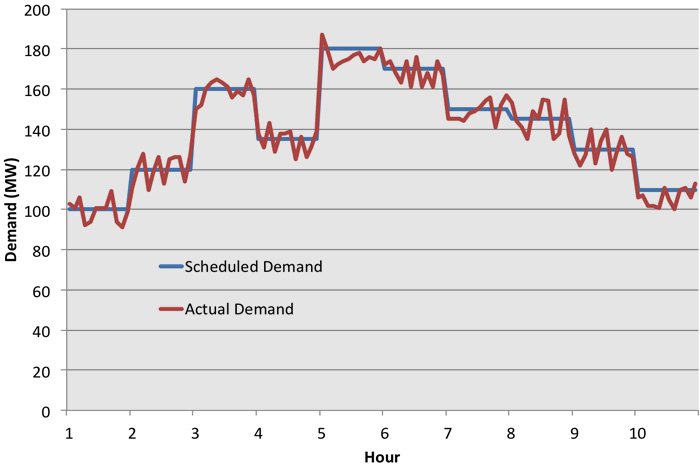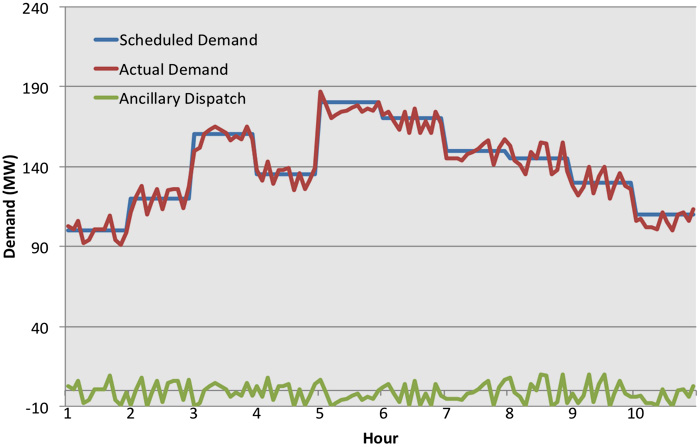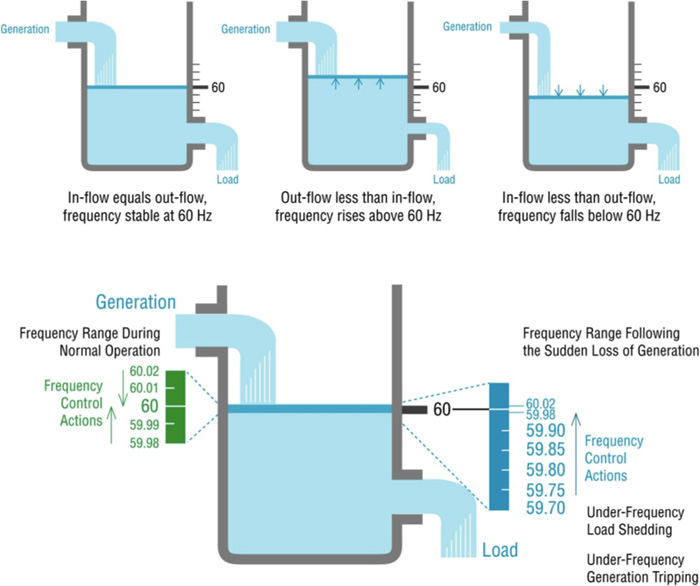Ancillary Services
In a power grid, supply and demand must be matched at every second. In order to keep the grid operating reliably, system operators need a portfolio of backup resources in case of unplanned events. These backup resources are collectively known as “ancillary services.” These are purchased by the system operator through a type of option arrangement. The system operator might have an agreement with a power plant that gives the system operator the right to start up or shut down that plant if a contingency arises on the power grid, or if demand increases or decreases in ways that the system operator did not predict.
A very simple example of how this might work is shown in Figures 12.6 and 12.7. Figure 12.6 illustrates a hypothetical power system with some amount of predicted or “scheduled” demand. Actual demand deviates from this scheduled demand by small amounts – sometimes higher and sometimes lower. Figure 12.7 shows how a generator providing ancillary services would change its output in response to demand fluctuations – a practice known as “load following.” Ancillary services are the primary mechanisms currently in place for system operators to accommodate unanticipated variations in VER output.


There are many different flavors of ancillary services. Please read the “Ancillary Services Primer” which provides some more detailed information. Two types of ancillary services are of particular relevance for VER integration – reserves and regulation.
“Reserves” represent backup generation that can be called upon in a certain amount of time in case of a contingency on the power grid, like the unexpected loss of a generator or transmission line (interestingly enough, it’s not clear whether or not the unanticipated loss of a VER for resource reasons, like the wind stops blowing, is considered a “contingency” in the eyes of reliability regulators). There are two types of reserves:
- Spinning Reserves: Generation that is synchronous with the grid (“spinning”) and is able to increase power in 10, 30, or 60 minutes (depending on the flavor).
- Non-spinning reserves: Generation that can start up and provide power within a specified time frame (usually 30 or 60 minutes).
“Frequency regulation” or just “regulation” refers to the generation that can respond automatically to detected deviations from the frequency at which all generators in a synchronous AC system are rotating (in the US, this is 60 Hertz; some other countries use 50 Hertz). Regulation is sometimes called “automatic generation control” since the response is typically too fast for a human being to initiate.
Regulation is, at this point in time, the most relevant ancillary service for VER integration and is also one of the most difficult to understand. The frequency of the power grid needs to remain constant at 50 or 60 Hertz (depending on the country). That frequency is related to the demand-supply balance. It may be helpful to think about frequency as analogous to the water level in a bathtub, as illustrated in Figure 12.8. The balance of demand and supply is like the tub having an identically-sized faucet and drain. If the faucet is larger than the drain, the water level rises – and in a power grid if the supply is larger than the demand, then the frequency will go up. If the drain is larger than the faucet (or if demand exceeds supply), then the system frequency declines.

Frequency regulation as an ancillary service corrects for frequency deviations by increasing or decreasing the output of specific generators, usually by small amounts, in order to effectively increase or decrease the size of the faucet relative to the drain. Response times for generators providing regulation are typically on the order of seconds, which is primarily why frequency regulation is used as a way for system operators to ride through unanticipated fluctuations in VER output.
